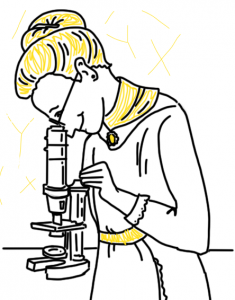An Everyday DNA blog article
by: Sarah Sharman, PhD, Science writer
Illustrated by: Cathleen Shaw
Each year in March the United States celebrates Women’s History Month. It began as a week in 1980 and evolved into a whole month in 1987. Women’s History Month honors the generations of women and girls who helped build our nation, shape our progress, and strengthen our character.
 Throughout history, their monumental contributions to our society were often overlooked or attributed to men. Brilliant women like Dr. Rosalind Franklin who discovered the DNA double helix structure, Alice Ball who discovered a cure for leprosy, Dr. Katherine Johnson who calculated the exact path of the country’s first manned spaceflight, and countless others made groundbreaking discoveries in their fields, yet received little or no recognition during their lifetime.
Throughout history, their monumental contributions to our society were often overlooked or attributed to men. Brilliant women like Dr. Rosalind Franklin who discovered the DNA double helix structure, Alice Ball who discovered a cure for leprosy, Dr. Katherine Johnson who calculated the exact path of the country’s first manned spaceflight, and countless others made groundbreaking discoveries in their fields, yet received little or no recognition during their lifetime.
For postdoctoral fellow Dr. Sarah Carey and Auburn University PhD student Laramie Aközbek, this year’s Women’s History Month was all about honoring a forgotten visionary in their field of study – Dr. Nettie Maria Stevens. Sarah and Laramie, both members of the Harkess lab at the HudsonAlpha Institute for Biotechnology, recently published a review article highlighting Dr. Stevens’ contributions to the field of sex chromosome biology.
Dr. Stevens was an American geneticist who discovered sex chromosomes. In the early 1900s, while peering through a microscope, Dr. Stevens discovered that male mealworms produce two kinds of sperm, one with a large chromosome and one with a small chromosome. She further observed that when eggs were fertilized with sperm having a large chromosome, they produced female offspring. But when eggs were fertilized with sperm having a small chromosome, they produced male offspring. Thus, she concluded that sex is inherited as a chromosomal factor and males determine the gender of the offspring.
Her seminal work was published as a two-part book called Studies in Spermatogenesis, with the first part being published in 1905. Despite the importance of Stevens’ work and over 6000 peer-reviewed articles on the topic of sex chromosomes since it was published, Studies in Spermatogenesis has been cited fewer than 100 times.
I had the pleasure of sitting down with Sarah and Laramie to discuss the importance of Dr. Stevens’ work to their scientific endeavors. To hear our conversation and learn more about the work of Dr. Stevens, watch the video below.


